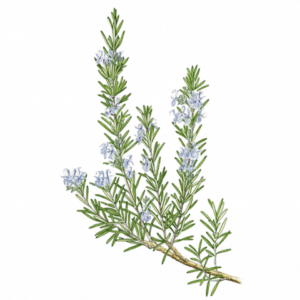

ROSEMARY CAMPHOR
Rosmarinus officinalis
Camphoriferum
DESCRIPTION

Camphor rosemary (Rosmarinus officinalis camphoriferum) is a shrub of the Lamiaceae family native to the Mediterranean area. It is one of the “herbes de Provence”.
ADVICE
DO NOT USE IN
– pregnant or breast-feeding women,
– children under the age of seven years,
– persons allergic to one of the components (geraniol, linalool, limonene),
– subjects with asthma without the advice of an allergologist before the first use,
– subjects with epilepsy (or children who have had fever seizures).
RECIPES
Cellulite
Mix 10 drops of essential oil of rosemary camphor in one tablespoon of arnica carrier oil. Massage the areas concerned.
Hair loss
Before applying your shampoo, massage your scalp with 10 drops of essential oil of rosemary camphor in 1 tablespoon of carrier oil (or 3 drops of essential oil for 4 drops of carrier oil).
Circulation
Massage your legs with 10 drops of essential oil of rosemary camphor in one tablespoon of carrier oil.

Its stem, that can reach two metres in length, is covered with a greyish bark and divides into opposing branches. Its persistent leaves are longer than they are wide, with slightly rolled edges. Its blue tending towards purple flower spikes blossom from January to May. Rosemary prefers sun-drenched garrigues and scrubland. Rosemary was cultivated as far as three thousand years ago between the Tigris and Euphrates rivers, for its medicinal virtues. In Rome, Vespasian mentioned it in his fiscal list of flavourings. It was placed on graves to ensure immortality and, in Ovid’s Metamorphoses, it arose from the blood of a princess killed by her father to punish her for having given in to Apollo’s advances. The Middle Ages could not forego a good legend: rosemary flowers were white but, just before giving birth to Jesus, Mary laid her blue cape on them, giving them their blue colour. The plant’s benefits are numerous, though one predominates. The famous “Queen of Hungary’s water” was made from rosemary flowers. According to legend, this 19th century sovereign, who could not get over being, and more importantly, looking seventy two years of age, regained a fresh and young appearance, along with a suitor.
CULTIVATION AND PRODUCTION
Rosemary grows wild on the Mediterranean coast; it is one of the most extensively cultivated plants in France. In Corsica, where it is abundant (hence its designation Corsican blue), its intense blue flowers and multiple virtues have led to its being nicknamed a man di Diu (the hand of God). It is also produced in Tunisia, Morocco, Italy and Spain.
FRAGRANCE
The scent of rosemary is fine, spicy and fresh.
EXTRACTION AND YIELD
The steam distillation of the flowering tops of rosemary gives a yield of 0.4%, i.e. four hundred grams from one hundred kilograms of plant.
CHEMICAL FORMULA
Rosemary possesses multiple chemotypes, depending on where it is cultivated. All contain camphor, but in different proportions: rosemary camphor contains 20% on average, rosemary 1,8-cineol/eucalyptol contains approximately 10% and rosemary verbenone contains between 3 and 8%. These different chemotypes give the plant different properties that must not be confused. The main active constituents of essential oil of rosemary are the same for the different chemotypes, though in varying proportions: monoterpenes (alpha-pinenes, beta-pinenes, camphene), sesquiterpenes, terpene oxides (1,8-cineol) and monoterpenones (camphor).
MAIN INDICATIONS
Essential oil of rosemary camphor is a potent stimulant and gives tone to a tired body. It relieves “heavy legs” and attenuates cellulite. it facilitates digestion and relieves aches, cramps and muscle pain.


Leave a Comment